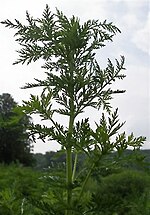Malaria Treatment using TCM? Effective?
-
Artemisinin
Artemisia has been used by Chinese herbalists for more than a thousand years in the treatment of many illnesses, such as skin diseases and malaria. The earliest record dates back to 200 BC, in the "Fifty-two Prescriptions" unearthed from the Mawangdui Han Dynasty Tombs. Its antimalarial application was first described, in Zhouhou Beiji Fang ("The Handbook of Prescriptions for Emergencies", Chinese: 肘�备急方), edited in the middle of the fourth century by Ge Hong. In that book, 43 malaria treatment methods were recorded, including to shout loudly with a cock in hands, or to eat two halves of one soy bean with Chinese characters for "sun" and "moon" written on.
In the 1960s a research program, under the name Project 523, was set up by the Chinese army to find an adequate treatment for malaria. In 1972, in the course of this research, Dr. Tu Youyou[4] discovered artemisinin in the leaves of Artemisia annua (annual wormwood). [5] The drug is named Qinghaosu (Chinese: é�’è’¿ç´ ) in Chinese. It was one of many candidates then tested by Chinese scientists from a list of nearly 5000 traditional Chinese medicines for treating malaria. It was the only one that was effective, but it was found that it cleared malaria parasites from their bodies faster than any other drug in history. Artemisia annua is a common herb and has been found in many parts of the world, including along the Potomac River, in Washington, D.C. Images of the original scientific papers are available online[6] and a book, Zhang Jianfang, "Late Report – Record of Project 523 and the Research and Development of Qinghaosu", Yangcheng Evening News Publisher 2007(å¼µåŠ�æ–¹. é�²åˆ°çš„å ±å‘Šäº”äºŒä¸‰é …ç›®èˆ‡é�’è’¿ç´ ç ”ç™¼ç´€å¯¦. ç¾ŠåŸŽæ™šå ±å‡ºç‰ˆç¤¾, 2007),[7] was published in 2006, which records the history of the discovery.
It remained largely unknown to the rest of the world for about seven years, until results were published in the Chinese Medical Journal in 1979.[8] The report was met with skepticism at first, partly because the chemical structure of artemisinin, particularly the peroxide, appeared to be too unstable to be a viable drug.
For many years after the discovery, access to the purified drug and the plant it was extracted from were restricted by the Chinese government.[2] It was not until the late 1970s and early 80s that news of the discovery reached scientists outside China. The World Health Organisation (WHO) tried to contact Chinese scientists and officials to find out more, but drew a blank. Dr Ying Lee, one of the scientists involved in the research into artemisinin, said the Chinese distrusted the West.[citation needed] The Chinese suspected the West just wanted to exploit the drug and sell it around the world slightly altered and repatented. The fact that there were several Americans on the WHO's steering board on malaria and that some were from the military did not help clear the distrust. It can be noted Americans had just invested a lot into mefloquine, an analogue of quinine.
In 2006, after artemisinin had become the treatment of choice for malaria, the WHO called for an immediate halt to single-drug artemisinin preparations in favor of medications that combine artemisinin with another malaria drug, in order to reduce the risk of parasites developing resistance.[9] In 2011, Dr. Tu was awarded the prestigious Lasker-DeBakey Clinical Medical Research Award for her discovery.[10][5]
-
Fighting Malaria: The Army's New Weapon Against a Killer
Watch the following videos
